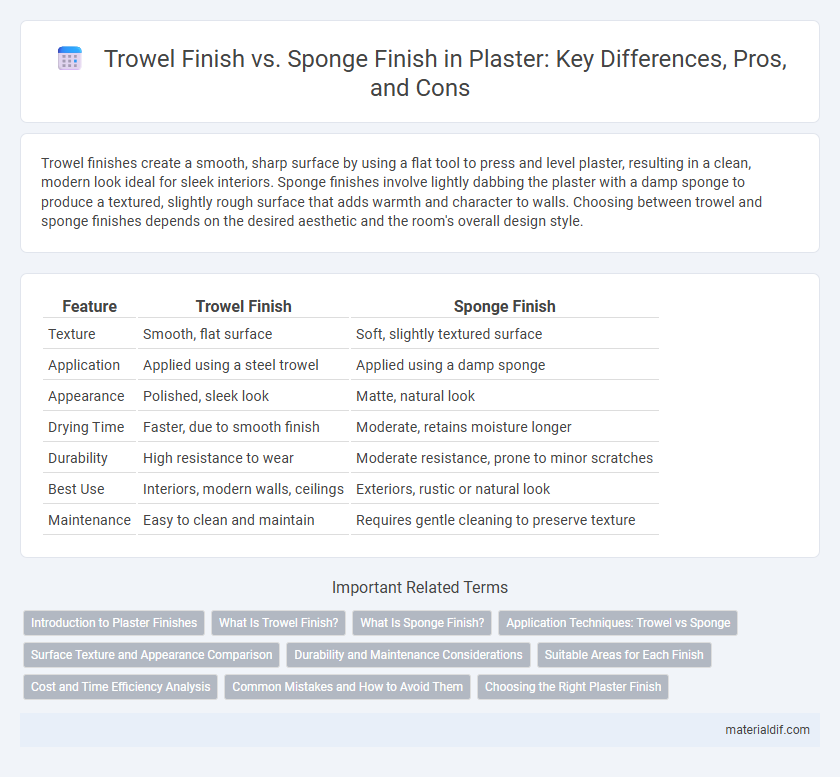Trowel finishes create a smooth, sharp surface by using a flat tool to press and level plaster, resulting in a clean, modern look ideal for sleek interiors. Sponge finishes involve lightly dabbing the plaster with a damp sponge to produce a textured, slightly rough surface that adds warmth and character to walls. Choosing between trowel and sponge finishes depends on the desired aesthetic and the room's overall design style.
Table of Comparison
| Feature | Trowel Finish | Sponge Finish |
|---|---|---|
| Texture | Smooth, flat surface | Soft, slightly textured surface |
| Application | Applied using a steel trowel | Applied using a damp sponge |
| Appearance | Polished, sleek look | Matte, natural look |
| Drying Time | Faster, due to smooth finish | Moderate, retains moisture longer |
| Durability | High resistance to wear | Moderate resistance, prone to minor scratches |
| Best Use | Interiors, modern walls, ceilings | Exteriors, rustic or natural look |
| Maintenance | Easy to clean and maintain | Requires gentle cleaning to preserve texture |
Introduction to Plaster Finishes
Trowel finish creates a smooth, dense surface by compacting plaster with a flat steel tool, ideal for durable walls and ceilings. Sponge finish involves gently rubbing the plaster with a wet sponge, producing a textured, matte appearance that enhances aesthetic appeal and helps mask minor imperfections. These plaster finishes offer different visual and tactile qualities, influencing both the functionality and style of interior surfaces.
What Is Trowel Finish?
Trowel finish refers to a smooth, polished plaster surface achieved by repeatedly applying and smoothing plaster with a steel trowel. This technique creates a sleek, durable finish often used on interior walls and ceilings for a refined appearance. The dense texture provides excellent resistance to moisture and wear, making it suitable for high-traffic areas.
What Is Sponge Finish?
Sponge finish is a plaster finishing technique that involves using a damp sponge to create a textured, smooth surface by lightly dabbing or wiping the plaster before it fully dries. This finish enhances the visual appeal and adds subtle texture, making walls more resistant to minor imperfections and easier to maintain. Commonly used in decorative plasterwork, sponge finish provides a softer, more organic look compared to the crisp, uniform appearance of a trowel finish.
Application Techniques: Trowel vs Sponge
Trowel finish involves applying plaster with a flat, smooth-edged tool to create a sleek, polished surface favored for its durability and uniform appearance. Sponge finish uses a damp sponge to gently texture the plaster, producing a softer, more natural look that conceals minor imperfections. Understanding the differences in application techniques helps achieve desired aesthetic and functional results depending on project requirements.
Surface Texture and Appearance Comparison
Trowel finish creates a smooth, dense surface with a polished sheen, ideal for modern or minimalist designs requiring a sleek and uniform appearance. Sponge finish produces a textured, slightly rough surface with a subtle matte look, enhancing visual interest and masking minor imperfections on plaster walls. The choice between trowel and sponge finish significantly influences the plaster's tactile quality and aesthetic, affecting both durability and style in architectural applications.
Durability and Maintenance Considerations
Trowel finish plaster offers superior durability due to its dense and smooth surface, making it more resistant to cracks and wear over time. Sponge finish, while providing a textured and aesthetically pleasing look, tends to require more frequent maintenance as its porous surface can trap dirt and moisture, leading to potential deterioration. For long-term durability and minimal upkeep, trowel finish is typically the preferred choice in plaster applications.
Suitable Areas for Each Finish
Trowel finish is ideal for smooth, durable surfaces commonly used on walls and ceilings in residential and commercial interiors. Sponge finish suits areas requiring a textured, decorative effect, such as feature walls, fireplaces, and exterior facades. Selecting the appropriate finish depends on the desired aesthetic and functional requirements of the specific application site.
Cost and Time Efficiency Analysis
Trowel finish plaster generally offers higher time efficiency due to its faster application and quicker drying process compared to sponge finish, which requires more labor-intensive steps and longer curing times. Cost-wise, trowel finish tends to be more economical, as it reduces labor hours and material waste, while sponge finish may incur higher expenses from additional labor and materials to achieve the textured surface. Contractors focused on budget and project timelines typically prefer trowel finish for its balance of quality, cost savings, and operational speed.
Common Mistakes and How to Avoid Them
Common mistakes in trowel finish involve uneven pressure leading to surface ridges, which can be avoided by applying consistent, smooth strokes with a well-chosen trowel. In sponge finish, over-wetting the sponge causes a blotchy texture; maintaining a damp but not saturated sponge ensures uniformity. Proper timing and tool maintenance are crucial to achieve a professional plaster finish in both techniques.
Choosing the Right Plaster Finish
Trowel finish offers a smooth, polished surface ideal for modern interiors and requires skilled application for durability and aesthetic appeal. Sponge finish creates a textured, slip-resistant surface that enhances grip and is often chosen for exterior walls or wet areas. Selecting the right plaster finish depends on the desired look, functionality, and environmental conditions of the space.
Trowel finish vs Sponge finish Infographic

 materialdif.com
materialdif.com